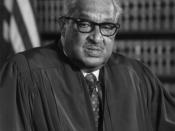As late as the 1950s, society in the Southern United States remained racially segregated by law. The segregation laws in these states were supported by an 1896 Supreme Court ruling. In the case of PLessy vs. Ferguson, the Court had ruled that "seperate but equal" public facilities for blacks and whites did not violate the Constitution. This ruling set a pattern that forced Southern black Americans to live almost totally segregated from white society.
A strong civil rights movement in the United States had developed by the 1950s, and ending segregation in public schools became one of its primary targets. The National Association for the Advancement of Colored People (NAACP) won a legal battle to gain admission for qualified black Americans to professional and graduate schools. NAACP lawyers, led by Thurgood Marshall, then took the broader issue of segregatioin in public schools.
In 1954 the Supreme Court agreed to hear the case of Brown vs.
the Board of Education of Topeka, Kansas. The case involved Linda Brown, an eight year old black girl from Topeka. Linda was required to attend an all black school 20 blocks from her home, even though there was an all white school only a few blocks away. With help from the NAACP, Linda's father, Oliver Brown, sued the Topeka Board of Education so that his daughter could attend the nearby all whtie school. NAACP lawyer Thurgood Marshall challenged the Plessy vs. Ferguson ruling and argued that even if seperate black schools were equal to white schools, black children were still suffering great psychological damage.
On May 17,1954, Chief Justice EArl Warren announced that it was the unanimous decision of the Court that "seperate educational facilities are inherently unequal." Warren said that to separate grade school children "solely because of their race generates a feeling...


